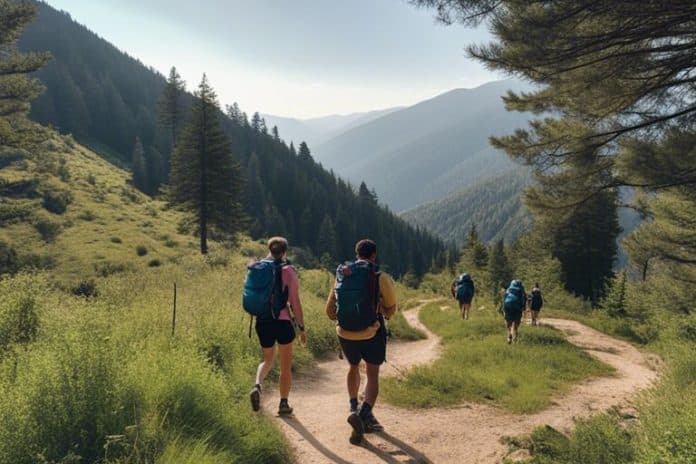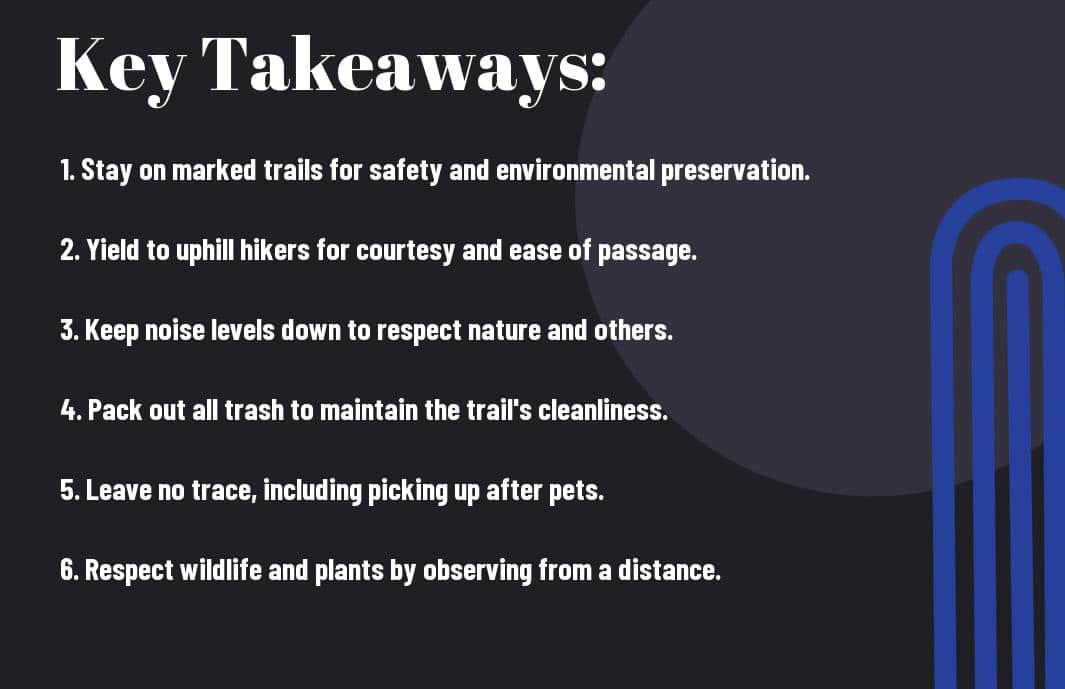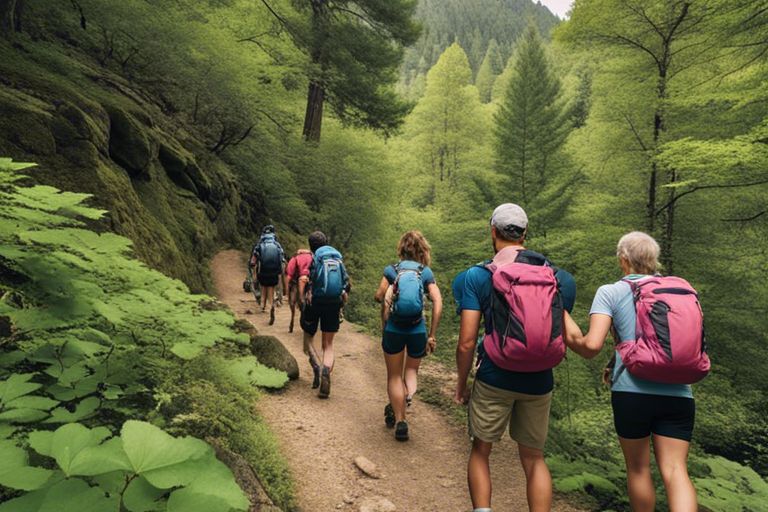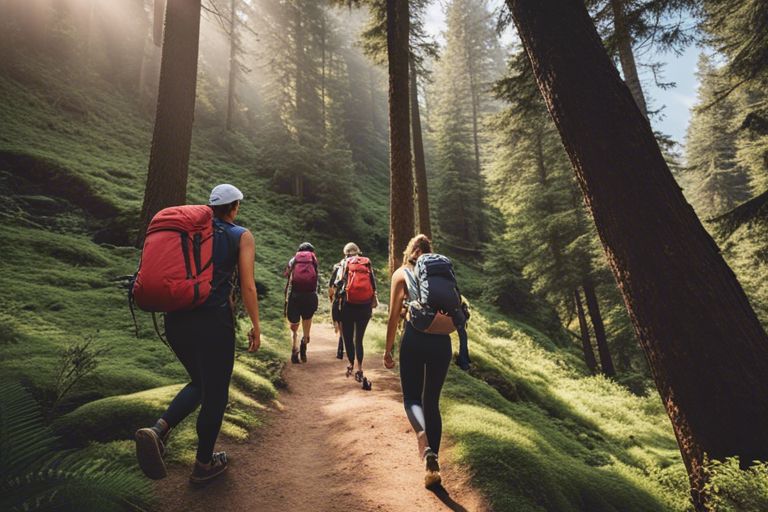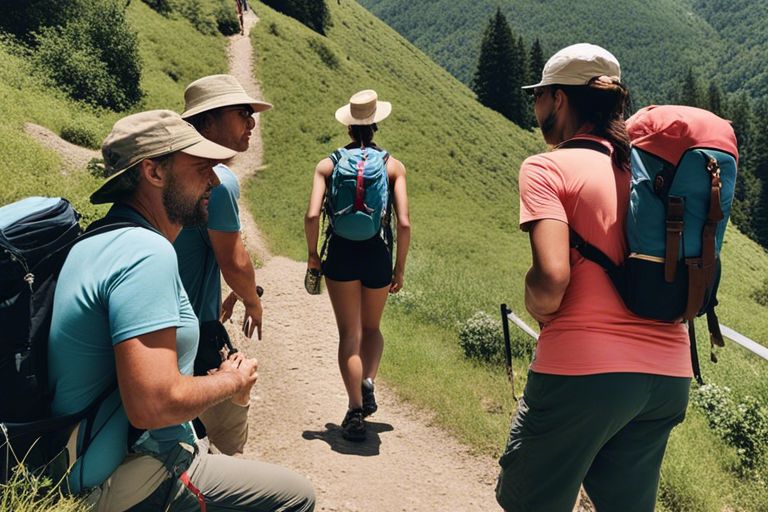Many outdoor enthusiasts enjoy hiking for the physical benefits and the connection to nature it provides. However, it is crucial to follow proper hiking etiquette to ensure a safe and enjoyable experience for everyone on the trail. From yielding to others to respecting wildlife, there are crucial rules that every hiker should know. To learn more about the basic rules of etiquette when hiking a busy trail, visit What are the basic rules of etiquette when hiking a busy trail?.
Key Takeaways:
- Stay on the designated trails: Avoid damaging the environment by straying off the path, as this can erode soil and destroy vegetation.
- Be mindful of other hikers: Give way to those going uphill, keep noise levels down, and respect their space during breaks.
- Leave no trace: Pack out all trash, stay on designated paths, and avoid damaging plants or wildlife.
- Yield to wildlife: Keep a safe distance from animals, observe quietly, and never feed them.
- Follow proper hiking etiquette: Yield to horses and mountain bikers, announce your presence when passing, and keep pets on a leash.
- Be prepared: Bring enough water, food, appropriate clothing, and emergency supplies in case of unexpected situations.
- Respect nature: Do not disturb plants or wildlife, avoid picking flowers, and be mindful of noise levels to preserve the calming atmosphere of the outdoors.
Before You Hit the Trail
Little can compare to the experience of hiking in the great outdoors, surrounded by nature’s beauty and tranquility. However, before you lace up your boots and hit the trail, there are a few things to consider to ensure a safe and enjoyable journey.
Preparation and Planning
Preparation is key when begining on a hiking adventure. Make sure to check the weather forecast, inform someone of your planned route and estimated return time, pack plenty of water and snacks, and carry a map or GPS device. Proper clothing and footwear are vital to ensure your comfort and safety on the trail.
Understanding Trail Priority
With numerous hikers, bikers, and sometimes even equestrians sharing the trails, it’s important to understand trail priority to avoid conflicts and ensure a smooth hiking experience. Hikers typically have the right of way over bikers and should yield to uphill hikers. Always be courteous and yield to others, especially those moving uphill, and be mindful of noise levels to respect the natural environment and wildlife.
Understanding and adhering to trail priority not only promotes safety but also enhances the overall hiking experience, allowing everyone to enjoy the trail peacefully and harmoniously. Recall, being respectful of others and following proper etiquette can go a long way in preserving the trails for future generations to enjoy.
Dos and Don’ts on the Trail
Right of Way on the Trail
For a smooth hiking experience, it is crucial to understand and follow the right of way on the trail. Hikers going uphill generally have the right of way, as it is more challenging to regain momentum after stopping on an incline. When encountering others on the trail, yield by moving to the side and allowing them to pass safely. Being courteous and aware of your surroundings can help prevent accidents and enhance everyone’s enjoyment of the hike.
Leave No Trace Principles
Principles of Leave No Trace are crucial guidelines to follow while hiking to preserve the natural beauty of the outdoors and minimize environmental impact. Remember to pack out all trash, even biodegradable items like fruit peels. Avoid picking plants or disturbing wildlife, and stay on designated trails to prevent habitat destruction. By adhering to these principles, you contribute to the sustainability of the ecosystem and ensure that future generations can enjoy the trails as well.
With Leave No Trace Principles, hikers can minimize their footprint on the environment and protect the wilderness for years to come. By respecting wildlife and habitats, avoiding littering, and staying on marked trails, outdoor enthusiasts play a significant role in preserving the natural beauty of the landscape. Educating yourself and others on these principles is key to fostering a culture of environmental stewardship among hikers worldwide.
Interacting with Others
Greeting Fellow Hikers
Once again, while on the trail, it’s vital to acknowledge and greet fellow hikers. A simple ‘hello’ or a nod goes a long way in fostering a sense of camaraderie and respect among hikers. Remember to be friendly and courteous to others on the trail.
Dealing with Pets and Wild Animals
For hikers bringing pets on the trail, it’s crucial to keep them on a leash at all times. This not only ensures the safety of your pet but also of other hikers and wildlife. Pets can disturb the natural habitat and wildlife, so it’s important to be responsible for their actions.
With pets and wild animals, it’s vital to remember that not all hikers are comfortable around them. Some may have allergies or fear of animals, so be respectful and maintain control of your pets. Wild animals can be unpredictable and potentially dangerous, so be cautious and keep your distance. Always follow guidelines for encounters with wildlife and never feed or approach them.
Dealing with Emergencies
After enjoying a hike in the great outdoors, it’s necessary to be prepared to deal with emergencies that may arise on the trail. Whether it’s a minor injury or a more serious situation, knowing how to handle emergencies can make all the difference in ensuring everyone’s safety.
Common Trail Hazards
Hazards on the trail can range from slippery rocks and roots to encounters with wildlife. It’s important to always watch your step, stay on marked trails, and be aware of your surroundings to avoid potential dangers. In case of an emergency, stay calm, assess the situation, and seek help if needed.
Emergency Practices and First Aid
To effectively handle emergencies on the trail, it’s crucial to have basic knowledge of first aid practices. Carry a first aid kit with necessary supplies such as bandages, antiseptic wipes, and pain relievers. In the event of an emergency, assess the injured person’s condition, provide immediate care, and contact emergency services if necessary.
With proper preparation and quick action, you can effectively respond to emergencies and ensure the well-being of yourself and others on the trail. Stay informed on basic first aid practices and have a plan in place for emergency situations to hike safely and responsibly.
To wrap up
On the whole, practicing good hiking etiquette is vital for a safe and enjoyable experience on the trail. By following these dos and don’ts, you can help preserve nature, respect other hikers, and contribute to a positive hiking community. Remember to always stay on the designated paths, be mindful of wildlife, pack out all your trash, and yield to others. With a little effort and consideration, we can all continue to enjoy the beauty of the great outdoors for years to come.
FAQ
Q: Why is hiking etiquette important on the trail?
A: Hiking etiquette is crucial on the trail to ensure the safety and enjoyment of all hikers. Following proper etiquette helps minimize conflicts, environmental impact, and promotes a positive hiking experience for everyone.
Q: What are some dos of hiking etiquette?
A: Some dos of hiking etiquette include yielding to other hikers on the trail, staying on designated paths, packing out all trash, being mindful of noise levels, and respecting wildlife and natural surroundings. Additionally, it is important to follow Leave No Trace principles to minimize your impact on the environment.
Q: What are some don’ts of hiking etiquette?
A: Some don’ts of hiking etiquette include playing loud music, leaving trash behind, disturbing wildlife, vandalizing natural areas, cutting switchbacks, and overcrowding viewpoints or trail areas. It is imperative to be considerate of other hikers, wildlife, and the environment to maintain the integrity of the hiking experience for everyone.
